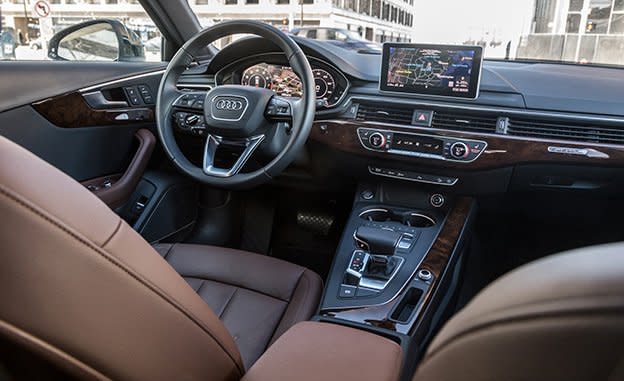2017 Audi A4 Allroad

From the May 2017 issue
The tracks in the virgin powder tell the story: Four of them, each flanked by its own spent roostertail of snow, are hallmarks of all-wheel-drive grace. That Audi’s A4 Allroad doesn’t perpetually turn the driveshaft that powers its rear axle differentiates it from every Quattro model sold in the U.S. since the original 1983 Quattro Coupe. That all four tires are pulling when needed, however, is apparent from behind the wheel. But the switch from front- to all-wheel drive is an instant, seamless, and transparent transition. Michèle Mouton would be proud.
Audi’s former factory driver would also, no doubt, approve of the Allroad’s launch-control-assisted 5.2-second stomp to 60 mph, the same as the last A4 sedan we tested and a meaningful second quicker than the similarly purposed Volvo V60 Cross Country T5 AWD. A 13.8-second quarter-mile puts to rest the notion that being a lifted wagon with a modicum of off-road capability also means being, well, slow. Audi’s turbocharged 2.0-liter inline-four pumps out the same 252 horsepower and 273 pound-feet of torque here that it does in the A4 sedan, sending it to the seven-speed dual-clutch paddle-shifted gearbox. The transmission remains a highlight of the driving experience: obedient and rapid when you need those traits, benign and invisible when you don’t.

But it’s the Allroad’s Quattro with Ultra system that’s the star of this wagon’s show. As an on-demand drivetrain, its fuel-saving capability exceeds that of many previous Quattros. Evaluated without the knowledge of its newfound complexity, its capabilities are as easy to trust as an autonomic heartbeat. Not once were we made aware of all that’s going on behind the scenes, despite relying consistently on all-wheel drive to pull us confidently through inches of fresh snow, treacherous ice, or sloppy mud. We measured 24 mpg, one less than the EPA’s combined rating, but two better than we saw in the A4 sedan, which uses the older, full-time all-wheel-drive hardware.
Built on Audi’s B9 platform, the Allroad wagon shares most of its suspension—its links, bushings, and anti-roll bars—with the A4 sedan. Its wheelbase is virtually identical as well (110.9 inches versus 111.0). It is, however, 2.6 inches taller thanks in part to fixed roof rails. Taller springs that raise the Allroad by 0.9 inch and taller 45-series rubber (another 0.4 inch) are responsible for 1.3 inches more ground clearance. But the Allroad, at heart, still feels like an A4—one with sleepy handling, sure, but with all the sedan’s straight-line speed, character, and quality. Adjustable dampers are included with the standard Audi Drive Select, which tailors the Allroad’s responses automatically or across its four modes: comfort, dynamic, off-road, and individual.

Selecting the off-road mode locks the Quattro system into all-wheel drive, decreases steering effort, and softens the dampers beyond their comfort-mode settings while disabling Audi’s pre-sense collision mitigation and preparation system. It’s a virtually imperceptible tweak that’s no more dramatic than switching into other drive modes.
Modest lateral grip and turn response are the Allroad’s penalties for being tall. All-season Continental ProContact TX rubber sized 245/45R-18 all around lacks the precision and stick of the optional 245/40R-18 Hankook summer tires on the A4 sedan. The roadholding diminishes from 0.90 g in the A4 to 0.85 g in the Allroad, but even so, there’s still a measure of precision here lacking in wagons from Subaru, Volkswagen, and Volvo. In dynamic mode, the Allroad will slay them all on a road with any meaningful twist. Then it’ll use its power advantage to disappear. And its 152-foot stop from 70 mph makes other wagons’ stopping performances appear downright Flintstones-like.
Inside, the Allroad is all Audi all the time—a potent combination of class-leading tech, stunning materials, and mil-spec control feel. The available 12.3-inch “virtual-cockpit” LCD instrument cluster is capable of multiple configurations, including a Google Earth map flanked by tachometer and speedometer gauges. Gray-oak or brown-walnut inlays on the dash, doors, and center console are optional. A 40/20/40 split-folding rear seat is standard. The coherence of the design presents more artfully than the spartan BMW 3-series theme yet is less chichi than Benz’s shinier-is-better C-class.


 Yahoo Autos
Yahoo Autos 